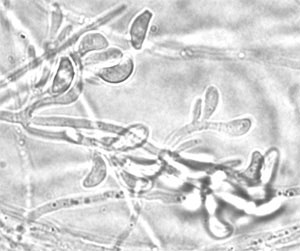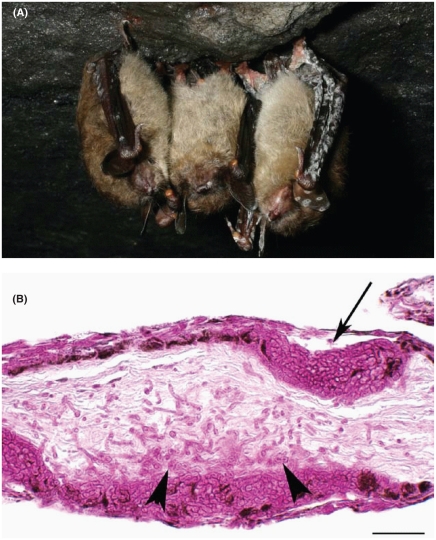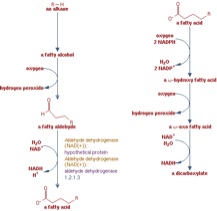Geomyces Destructans: Difference between revisions
Schmalingk (talk | contribs) |
Schmalingk (talk | contribs) |
||
| Line 28: | Line 28: | ||
{| | {| | ||
| height="10" bgcolor="#FFDF95" | | | height="10" bgcolor="#FFDF95" | | ||
'''NCBI: [http://www.ncbi.nlm.nih.gov/Taxonomy/Browser/wwwtax.cgi | '''NCBI: [http://www.ncbi.nlm.nih.gov/Taxonomy/Browser/wwwtax.cgi] [http://www.ncbi.nlm.nih.gov/entrez/query.fcgi?CMD=Display&DB=genomeprj Genome]''' | ||
|} | |} | ||
==Description and Significance== | ==Description and Significance== | ||
Revision as of 11:37, 3 May 2012
A Microbial Biorealm page on the genus Geomyces Destructans

Classification
Kingdon: Fungi
Subkingdom: Dikarya
Phylum: Ascomycota
Subphylum: Pezizomycotina
Class: Leotiomycetes
Order: Helotiales
Family: Myxotrichaceae
Genus: Geomyces
Species: Geomyces destructans
Description and Significance

Geomices destructans is a fungus thought to be responsible for the large number of bat deaths in New England over the last several years. It first presented itself in the US in 2006 and then in Europe specifically France, in 2009. Until recently G. destructans was thought to be a normal resident inhabiting bats around the world. Further research links this to “white nose syndrome,” and even more recent research shows a 100% match between the DNA of G. destructans and the fungus found on the dead bats [1]. (Chaturvedi et al) Further study is needed on this subject; reachers do not seem to be sure if the fungus is stemming from pest control measures or how and why this has recently devastated bats around the world.
Since first observation near Albany, NY in 2006, white nose syndrome has decimated populations of cave-hibernating bats in the northeastern United States, with mortality rates of 75-95%. In 2009, the infection area extended from northeastern New Hampshire to southwestern Virginia and expanded into Tennessee and Canada in 2010 [2]. Outside of North America, G. destructans has also been observed in colonized bats across Europe. It is not yet obvious how the infection is influencing the bat populations in Europe [10]. Description and Significance
.
Genome Structure
A total of 9075 genes coding for proteins have been sequenced for Geomyces destructans in a genome of 29,706,106 base pairs to code for them. Liner mitochondrial DNA has also been sequences but little information is available on genetic specifics at this time. (NCBI)http://www.ncbi.nlm.nih.gov/pubmed/.
Metabolism

"Fatty acid ω-oxidation in Geomyces destructns was researched by metacycy. http://metacyc.org/. Geomyces, along with other industrial yeasts, are capable of using fatty acids and alkanes as carbon sources. The methyl group at the end of the molecule is initially oxidized to a hydroxyl group, then to an oxo group, and terminally to a carboxyl group. The long chain of dicarboxylates derived from ω-oxidation then go into the β-oxidation pathway for further breakdown [6]. In the environment, polyunsaturated fatty acids, specifically linoleic and a-linolenic acid, are important for hibernating animals. Bats severely affected by White Nose Syndrome have been shown to exhibit higher amounts of α-linolenic acid in their white adipose tissue [7]. Contrariwise, bat species’ not heavily afflicted by white nose syndrome have higher amounts of linoleic acid in their white adipose tissue. In order for G. Destructans to survive it must utilize the α-linolnic acid as a carbon source. Dietary fatty acids can be excreted through sebaceous glands on the bat, which the fungus comes into contact with. G. destructans is unable to metabolize linoleic acid as a carbon source but may metabolize a-linolenic acid. If bats differ in their relative ratios of fatty acids this may play an important role in species, diet, and range specificity to white nose syndrome and hence bat survival [7]."
Ecology
White nose syndrome in bats was initially observed in 2006 at a single cave near Albany, New York. WNS has since been found in 14 states and 2 Canadian provinces, spreading up to 800 miles in 2009 [2]. This is of particular concern to scientists due to many bat species’ important role in their ecosystems. Not only does the decreasing umber of bats affect the environment but it also impacts humans. Bats are responcible for consuming large amounts of insects. A single Little Brown bat can consume one thousand insects in a night [2]. In the US, farmers spend significant amounts of money attempting to control pests, and with the decline of the bat population, farmers will be forced to take more drastic measures to regulate their crops and herds. This also increases the risk to humans from insect borne disease. Bats also feed the members of the microenvironments in caves. The loss of the bats to a cave, would destroy it’s ecosystem. G. Destructans is also known to speed between heavily visit caves without the help of bats. Spores of G. Destructans have been transferred from cave to cave through human contact as well as animal [2]. Other related species are commonly found in the soil and air and do not usually elicit an immune response in humans.
Pathology
G. destructans is a psychrophilic dermatophyte. This type of fungus can grown in cold conditions and cause infection of the skin due to it’s keratin obtaining ability. This fungus can attack the skin of muzzles, ears or wing membranes, and fills hair follicles, sebaceous glands and sweat glands. G. destructans negatively influences water balance in the bat, thus disrupting energy consumption. Infection with the fungus may also disrupt blood circulation and gas exchange through the skin [8]. Hyphae and white conidia powder have been found on bats, but the fungus elicits no immune response or inflammation when infected [3]. While the bats are hibernating, the fungus infects the designated areas and begins to replace and digest the living skin or tissues. Studies show that while bats are hibernating, their metabolism slows to a crawl, their body temperature decrease, and their immune system is depressed [9]. These conditions leave the bats susceptible to G. destructans which grows optimally at 1-15C.
Phages
Due to the danger of anthrax being used in biological weapons, research has been put into other methods, besides the highly controversial vaccine, to defend against the deadly disease. A recently discovered bacteriophage, the gamma phage, attacks Bacillus anthracis, and researches are optimistic about its clinical application. The bacteriophage is highly selective, and is extremely effective in lysing B. anthracis cells, while ignoring those of its closely related counterparts B. cereus and B. thuringiensis. The gamma phage has been over 80% effective in treating infected mice that were in the late stages of the disease, essentially rescuing them from almost certain death. There is the obvious concern that anthrax will develop strains that are immune to this treatment, and we will be right back where we started. Researchers say that this is unlikely because the only way to evade this predator would be a mutational change in cell wall structure to prevent the virus from binding, and this would kill the bacterium.
Medicine
Despite the pathogenic capabilities of some bacilli, many other species are used in medical and pharmaceutical processes. These take advantage of the bacteria's ability to synthesize certain proteins and antibiotics. Bacitracin and plymixin, two ingredients in Neosporin, are products of bacilli. Also, innocuous Bacillus microbes are useful for studying the virulent bacillus species that are closely related. B. subtilis has multiple carbohydrate pathways, representing the variety of carbohydrates found in the soil.
References
Innovation in Europe: The decoding of the Bacillus subtilis genome
University of Texas Medical Branch: Bacillus
University of Wisconsin-Madison: Bacillus anthracis and anthrax
Wipat, Anil & Colin R. Hardwood. 1999. The Bacillus subtilis genome sequence: the molecular blueprint of a soil bacterium. FEMS Microbiology Ecology, Vol. 28: 1-9.
